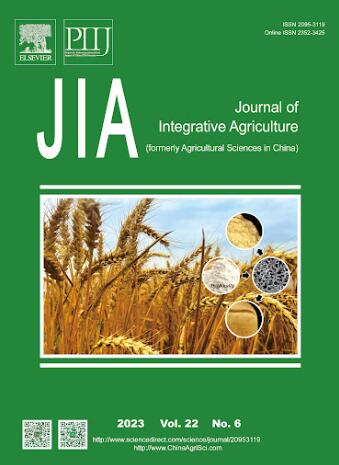甘蔗/大豆间作,减少氮的添加,在秸秆分解过程中提高残留物衍生的可变土壤有机碳和土壤中微生物网络的复杂性
IF 4.4
1区 农林科学
Q1 AGRICULTURE, MULTIDISCIPLINARY
引用次数: 0
摘要
甘蔗/大豆间作减氮是一种重要的可持续农业模式,可改变土壤生态功能,从而影响秸秆在土壤中的分解。然而,在长期间作减氮条件下,秸秆分解过程中土壤有机碳(SOC)组成和微生物群落的变化机制仍不清楚。在本研究中,我们在双因素(种植模式:甘蔗单作(MS)和甘蔗/大豆间作(SB);氮添加水平:减氮添加(N1)和常规氮添加(N2))长期试验田小区内进行了原位微地块培养实验,并添加了 C 标记的大豆秸秆残渣。结果表明,SBN1 处理显著增加了秸秆分解过程中残留颗粒有机碳(POC)和残留微生物生物量碳(MBC)的含量,土壤中的秸秆碳主要以 POC 的形式保存。秸秆的加入改变了土壤微生物群落的结构并降低了其多样性,但随着分解时间的延长,微生物多样性逐渐恢复。在秸秆分解过程中,间作模式显著增加了真菌和子囊菌的相对丰度。此外,在甘蔗/大豆间作模式中,秸秆的添加降低了微生物网络的复杂性,但在甘蔗单一种植模式中,秸秆的添加增加了微生物网络的复杂性。尽管如此,SBN1 处理的微生物网络复杂性仍然高于 MSN1 处理。总的来说,SBN1 处理显著增加了微生物群落的多样性以及与有机物分解相关的微生物的相对丰度,而微生物群落的变化主要是由残留的可溶性 SOC 部分驱动的。这些研究结果表明,在甘蔗/大豆间作的土壤中,减少氮的添加可以固碳更多的秸秆,从而保持微生物的多样性,促进可持续农业的发展。本文章由计算机程序翻译,如有差异,请以英文原文为准。
Sugarcane/soybean intercropping with reduced nitrogen addition enhances residue-derived labile soil organic carbon and microbial network complexity in the soil during straw decomposition
Sugarcane/soybean intercropping with reduced nitrogen addition is an important sustainable agricultural pattern that can alter soil ecological functions, thereby affecting straw decomposition in the soil. However, the mechanisms underlying changes in soil organic carbon (SOC) composition and microbial communities during straw decomposition under long-term intercropping with reduced nitrogen addition remain unclear. In this study, we conducted an in-situ microplot incubation experiment with C-labeled soybean straw residue addition in a two-factor (cropping pattern: sugarcane monoculture (MS) and sugarcane/soybean intercropping (SB); nitrogen addition levels: reduced nitrogen addition (N1) and conventional nitrogen addition (N2)) long-term experimental field plot. The results showed that the SBN1 treatment significantly increased the residual particulate organic carbon (POC) and residual microbial biomass carbon (MBC) contents during straw decomposition, and the straw carbon in soil was mainly conserved as POC. Straw addition changed the structure and reduced the diversity of the soil microbial community, but microbial diversity gradually recovered with decomposition time. During straw decomposition, the intercropping pattern significantly increased the relative abundances of Firmicutes and Ascomycota. In addition, straw addition reduced microbial network complexity in the sugarcane/soybean intercropping pattern but increased it in the sugarcane monoculture pattern. Nevertheless, microbial network complexity remained higher in the SBN1 treatment than in the MSN1 treatment. In general, the SBN1 treatment significantly increased the diversity of microbial communities and the relative abundance of microorganisms associated with organic matter decomposition, and the changes in microbial communities were mainly driven by the residual labile SOC fractions. These findings suggest that more straw carbon can be sequestered in the soil under sugarcane/soybean intercropping with reduced nitrogen addition to maintain microbial diversity and contribute to the development of sustainable agriculture.
求助全文
通过发布文献求助,成功后即可免费获取论文全文。
去求助
来源期刊

Journal of Integrative Agriculture
AGRICULTURE, MULTIDISCIPLINARY-
CiteScore
7.90
自引率
4.20%
发文量
4817
审稿时长
3-6 weeks
期刊介绍:
Journal of Integrative Agriculture publishes manuscripts in the categories of Commentary, Review, Research Article, Letter and Short Communication, focusing on the core subjects: Crop Genetics & Breeding, Germplasm Resources, Physiology, Biochemistry, Cultivation, Tillage, Plant Protection, Animal Science, Veterinary Science, Soil and Fertilization, Irrigation, Plant Nutrition, Agro-Environment & Ecology, Bio-material and Bio-energy, Food Science, Agricultural Economics and Management, Agricultural Information Science.
 求助内容:
求助内容: 应助结果提醒方式:
应助结果提醒方式:


